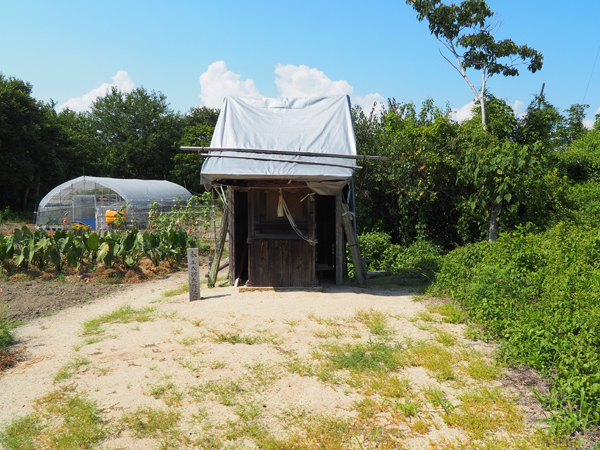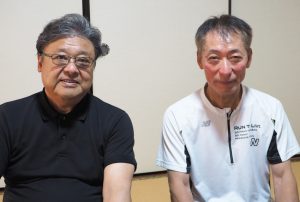Series “Visiting Villages” 35 A Trip to the Ado River Basin with the Author of “Shrines at Rest: The Changing Future of Sacred Places” ③

Shrines are symbols of the community and will exist forever. Many people probably believe this. Meanwhile, in areas experiencing depopulation, maintaining shrines is becoming increasingly difficult, sparking debate over whether they should be restored or demolished. (Kei Kitajima)
Seiichi Saito is the head of the parishioners of Aya Shrine in Takashima City. After retiring, he now produces Omi rice and Shine Muscat grapes as the representative of Seikichi Farm. In the winter, he also works as a ski instructor.
“Aya Shrine is the shrine of the Saito clan. When the Saito clan settled here, they picked up a stone from Lake Biwa and enshrined it as a sacred object, marking the beginning of Aya Shrine,” he explains.
As this is the Saito clan’s shrine, it is rare for anyone outside of the clan to visit.
The Saito clan’s history is long, dating back to the Heian period. From that time to the present, they have continued to protect this land, and even today, the Saito clan holds the Saito Festival once a year.
According to Koei Saito, who is well-versed in the history of the Saito clan, the Saito clan originally belonged to the “lake tribe.” They specialized in beach seine fishing, but they crossed the lake by boat, arrived at the sandbar, and began living in this area.
Although Aya Shrine has a deep history and tradition, it also faces challenges. The shrine is wavering over whether or not to repair the shrine. Currently, the roof is particularly badly damaged, and is being temporarily covered with a sheet.
“Building a new one would cost a lot of money, so no one is enthusiastic about it. Even if we were to repair it, it would cost a considerable amount of money,” says Saito Mitsuteru, folding his arms.
According to Professor Shimada, such cases are on the rise all over the country.
“Just the other day, a parishioner representative from Koka City, Shiga Prefecture, contacted me and asked if I could help with a meeting to discuss the future of shrines in the face of depopulation,” she says.
Originally, the intention was to discuss restoring the shrine, but those involved said that if they restored it now, they would have to do it again in a few decades. With the local population declining and no one knowing what the future holds, they suggested that it might be better to just demolish the shrine.
The parishioner representative had always thought that shrines were something that would last forever, so he was surprised to hear that there were people involved who were considering demolition, but there was some truth to his argument, so he decided to hold a meeting for serious discussion.
Professor Shimada says, “It’s true that what conditions must be met before discussions about closing shrines can begin? I would like to help the community find out. Currently, many places don’t discuss the future, even though it’s clear that maintaining a community will become difficult. Even if there is resistance to discussing the disappearance of a community, surely there can be a discussion about what to do with shared community assets like shrines.”

齊藤清吉氏㊨と齊藤光栄氏(Mr. Seikichi Saito (left) and Mr. Koei Saito
Meanwhile, Koei Saito says, “The position of parishioner representative is usually rotated for a one-year term. Once their term is over, they won’t be reappointed for several decades, so when I’m the parishioner representative, I make an effort to prevent the shrine from closing. As a result, discussions about closure don’t progress very quickly. Looking at it from another perspective, it’s precisely because of this repeated practice that the shrine has been able to build up such a long history. However, recently, some people have been refusing to become parishioner representatives, so there’s a chance that the shrine will disappear before discussions can even begin.”
Whether restoring or demolishing a shrine, a considerable cost is involved. Construction and labor costs have risen sharply in recent years, more than double the costs of 10 years ago. 。
It’s a burdensome issue, so perhaps there’s a psychological motivation to avoid it as much as possible.
“As is well known, the region is becoming increasingly depopulated. We don’t know what will happen to the next generation, so our generation has to do something. We all understand that. But how should we do it…” says Koei Saito.
In this regard, Shimada has one idea in mind: entrust the reconstruction of the shrine to architecture students.
“We will rebuild the local shrine as part of our training exercises. We will have the students learn the stories that the shrines carry, then design a new shrine that fits those stories and build it with their own hands. The other party will pay for the construction costs, but the students will actually build the shrine themselves. This will save money and lead to the revitalization of the local shrine. It will also generate news, giving people an opportunity to think about the region,” he says.
While some stakeholders, such as Seikichi and Koei, agree that it is a good idea, others are of the opinion that if it is to be carried out, they will have to rely on carpenters, so it seems that coming to an agreement will not be easy.
※Translating Japanese articles into English with AI
